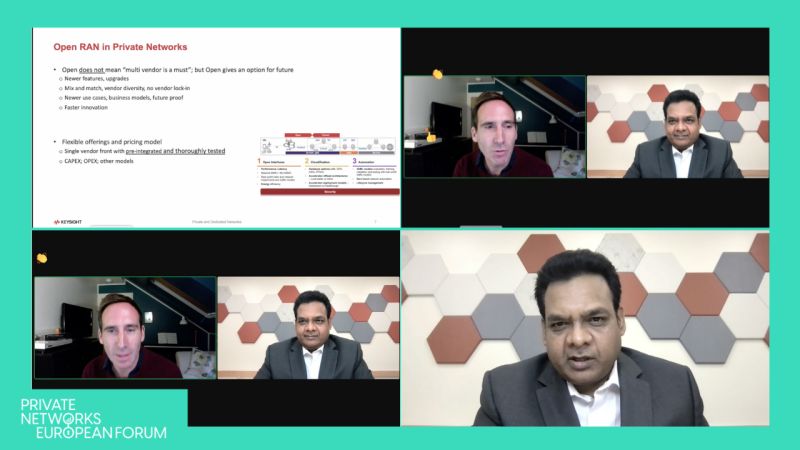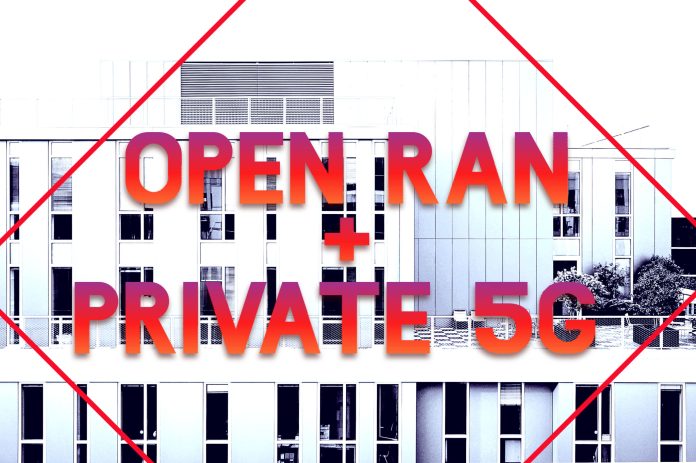Open RAN will triumph in private 5G, first. So said Jagadeesh Dantuluri, general manager for private networks at Keysight Technologies, speaking at Private Networks European Forum this week. These twin technologies (or tech splinter movements) represent “two of the most important things in wireless technology”, he said. They will combine, he suggested, to drive industrial revolution – or to set an additional networking springboard for it, at least. (Note, on-demand sessions from Private Networks European Forum are available now.)
Dantuluri, giving a presentation on the subject of ‘the future role of open RAN’ in 5G infrastructure, considered their parallel narratives, and how they converge in the enterprise space with rollout of private – or ‘non-public’ (NPN) – networks. This is because private NPN networks are smaller-scale in terms of their geographic footprint and functional remit – and because their sophistication can go in tandem with advances in open RAN developments.
He said: “[Private networks]… [are] quite limited in terms of footprint, and also in terms of users and devices… So mobility, say, will only be needed between a few cells, and maybe not at all. And there is not a requirement for massive MIMO and [connectivity in] five-to-seven bands.” Later, in response to a question about trade-offs in cost and (future) flexibility with open RAN versus performance (today) with conventional systems, he flipped the scenario.
“If you want to deploy open RAN in the consumer network, with thousands of cells, and millions of customers, then, yes, open RAN still doesn’t go to the [all the right] places – to provide massive MIMO, or to support five or seven bands. But in private networks… that is not the requirement; 95 percent of… installations… do not require those features. So [open RAN] performance [in private 5G is not] any lower compared to traditional technologies,” he said.

Development of open RAN – described also by Dantuluri as “the most disruptive evolution in [telecoms in] the last 15 years, since the iPhone” – is too soon, probably, for the decennial upgrade of public networks, at least this time, with rollout of 5G. But its principles – open radio access (RAN) interfaces, virtualized for the separation (disaggregation) of hardware and software, and standardised for off-the-shelf interoperability – are good for all of telecoms, he said.
“The industry is definitely moving towards open RAN,” he said. The point is the rise of private 5G affords open RAN makers another shot, to develop business and stay the course, as teething issues with radio functionality and system integration slow progress in mega-scale national 5G networks. Indeed, Dantuluri argued that open RAN will be the common thread for private networks – even as their growth varies between vertical sectors, and even sub-sectors.
His presentation at Private Networks European Forum, hosted by Enterprise IoT Insights and RCR Wireless, opened with an explanation of the multi-speed growth of private 5G in sectors like education, logistics, manufacturing, mining, and healthcare – mainly down to their different regulatory environments, he said, plus their appetite for risk. “The regulatory framework in manufacturing is very different to the regulatory framework for schools,” he noted.
It is the same with sub-sectors within each vertical – except that 5G pickup is more likely to change with its application. “Utilities are laying out private networks using LTE more proactively than the rest of the energy sector. It is the same with sea-ports and airports – sea-ports are going faster than airports,” he said. In terms of use cases, every enterprise just wants better connectivity, in the first instance – “for connected workers or connected devices”.
But then, on top of reliable coverage, “manufacturing wants… asset tracking and sea-ports [want] remote operation”, he reasoned. There are some other common, he added, which might accelerate open RAN in private networks: a lack of cellular expertise within enterprises, generally, and a failure on the part of the cellular industry to ‘talk the talk’ of enterprises – “about truck haulage in warehouses or containers in sea ports, instead of bits and bytes”.
Because Industry 4.0, into which telecoms slots as a bottom layer, is about problem solving, and not tech selling, or tech-washing. As the cliché goes. “Telecoms needs to adapt,” warned Dantuluri. But his initial thrust was that a “uniform strategy” with network selling – across verticals, and even in verticals – “does not work”, mainly because “use cases are all quite varied”. But this in-market and inter-market variation in 5G usage lends itself to open RAN.
Just as certain bottom-line commonalities for every enterprise in every vertical lend themselves to open RAN, he added. Because the more general thrust of the presentation was that open RAN is – or will be, eventually – cheaper (over time) and simpler (in single-vendor arrays to begin with, and complex multi-vendor integrations down the line); so enterprises can reduce cost and risk with off-the-shelf hardware, which can be easily managed and replaced.
“All of which means open RAN, where it stands today, is a perfect candidate to deploy and adapt in private networks,” said Dantuluri. Anyway, here are five-plus conclusions from the session at Private Networks European Forum, for why open RAN will prove itself in private 5G – as written and presented by Dantuluri on behalf of Keysight Technologies, and as ordered and re-presented by Enterprise IoT Insights. All the quotes are from Dantuluri.
Note, a replay (with slides) of the Open RAN in Private 5G session, by Jagadeesh Dantuluri from Keysight Technologies, from Private Networks European Forum, is available now.
1 | Because open RAN is cheap
“There is a demand [from enterprises] for very low cost… solutions… The other thing is most of these verticals do not have any cellular technology. Many don’t have LTE or 3G… They are green-field [sites]. So open RAN has an advantage from a cost perspective… The fact these greenfield [telco sites] [require]… less complex technology – [than all of this] bodes well for open RAN…
“Enterprises want flexible pricing [too] – some want op-ex, some want cap-ex… – [and] these models are evolving. As far as cost is concerned, the TCO for open RAN at this stage may initially match… traditional RAN, but most of the cost is about the integration… [and], over time, over three years and five years, open RAN definitely has a TCO advantage.”
2 | Because open RAN is easy
“There is a demand [from enterprises] for… simple to deploy solutions – as easy as Wi-Fi… [Because] none of them are telecom experts… [The size of the enterprise]… tells what kind of expertise they can put into running a private network. Small and medium [sized firms do not]… want to bother [with network management] – they just want to know it runs well… Large enterprises have the willingness, maybe, to monitor… and optimise the network.
“[There are] four different ways private networks are managed today: by the telco, by the enterprise itself, by some combination of the two, or by smaller OT specialists… [The] important thing is IT departments will play a key role… [so] these deployments [have to be] easy. IT departments are used to Wi-Fi networks, which are easy to deploy, monitor, and run. So irrespective of the technology, whether open RAN or not, [simplicity is important].”
3 | Because open RAN is capable (enough)
“[Private networks]… [are] quite limited in terms of footprint, and also in terms of users and devices… So mobility, say, will only be needed between a few cells, and maybe not at all. And there is not a requirement for massive MIMO and [connectivity in] five-to-seven bands…”
“If you want to deploy open RAN in the consumer network, with thousands of cells, and millions of customers, then, yes, open RAN still doesn’t go to the [all the right] places – to provide massive MIMO, or to support five or seven bands. But in private networks… that is not the requirement; 95 percent of… installations… do not require those features. So [open RAN] performance [in private 5G is not] any lower compared to traditional technologies,”
4 | Because open RAN is flexible
“[The point is you are not] locked in with a single vendor. [And so] all the advantages – like fast innovation, mix-and-match vendor diversity, and decreasing cost of the overall solution – are a possibility. It also gives an ability to deploy new use cases and business models the enterprise may not have thought about when deploying the early network…
“[Industrial companies] have very long upgrade cycles – sometimes 10 or 20 years. Which is why they are more careful about putting their critical machine operations on 5G – it takes time, and they take longer to deploy. [But] because their upgrade cycles are so long… they do not want to have a vendor lock-in. And open RAN eliminates vendor lock-in.”
5 | Because open RAN is improving
“This openness to multiple vendors brings a lot of complexity… [to the] integration and deployment. But those challenges are being worked on… The open RAN industry is releasing open reference designs, very similar to the Wi-Fi open reference designs… [And] almost every open RAN vendor is participating in a plug-fest, connecting their solutions and testing how they work [together] – for functional testing, performance testing, and so forth.
“Which enables interoperability [between] vendors. [This stuff] is not 100 percent, but it is getting there. [But] open RAN does not have to mean multi-vendor [from the start]. You can always start [small]… with a single vendor… It gives the option… in the future to get new features – because… more vendors will come in, [and] some… may develop new features much faster than others.”
6 | Because open RAN is a fait accompli
|[Despite] the complexities of the initial [integration] phases, [open RAN brings] all the advantages of [being able to] deploy new features more quickly, replace the vendors if they [aren’t working]. So, are manufacturing companies looking towards open RAN? They are absolutely looking at all of the technologies, and taking help from big consulting companies and SIs, and so forth, [with] the vendor selection process…
“[For a manufacturing company] the preference is to go with a big vendor. Because they are proven. [At the same time, they] do not know the technology well and [their] lifetime objective is for something to run well, with the lowest TCO. So [they want to know they can replace a vendor] if that vendor does not work well… That’s number one [thing]… But there is a misconception that the big vendors are not going to open RAN.
“They are still not there yet, completely – as it is supposed to be. But they have opened up. [And] I would [point out also that] some of the big OT players… will deploy and manage private networks using open RAN. And they know industry very well, and are moving towards open RAN – for all the reasons, like vendor diversity, and the ability to have fast innovation without having to rely on the big three or four.”

